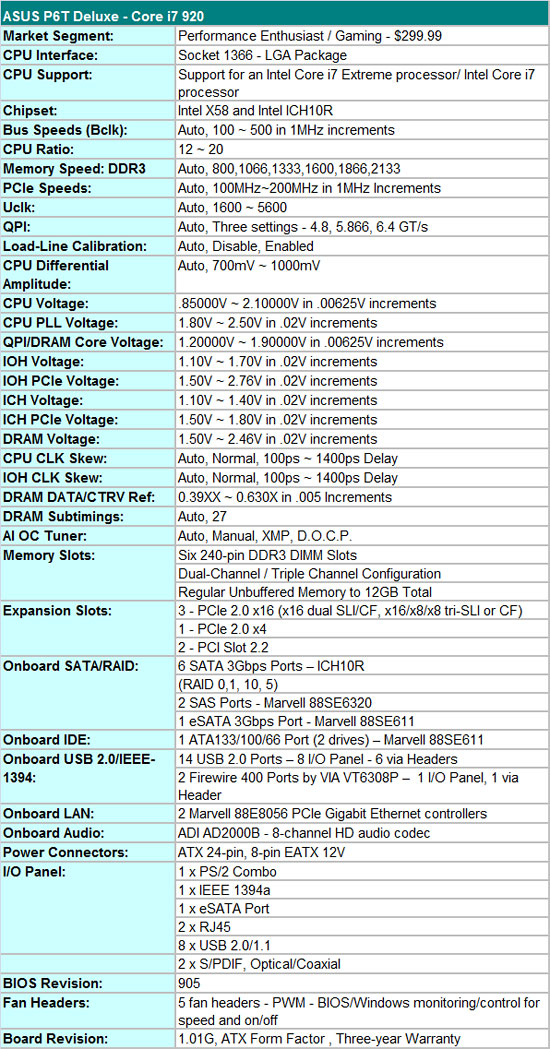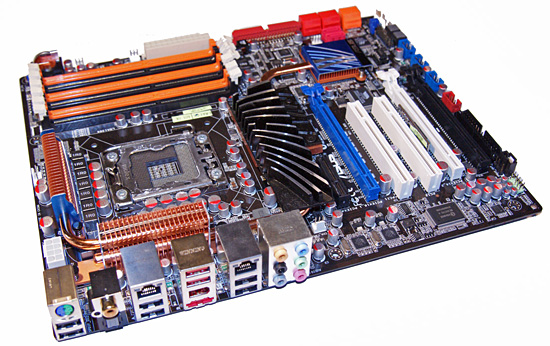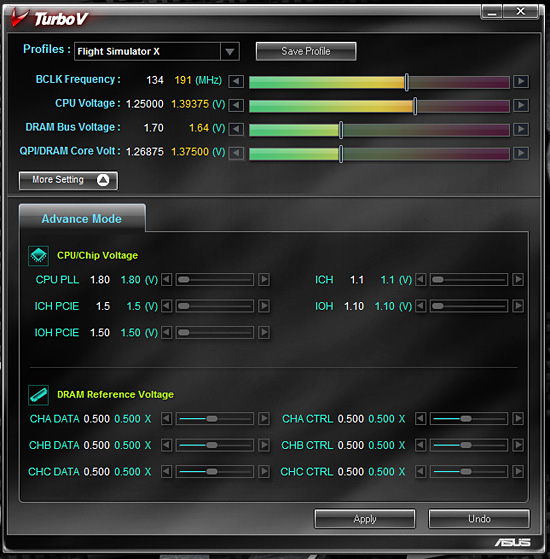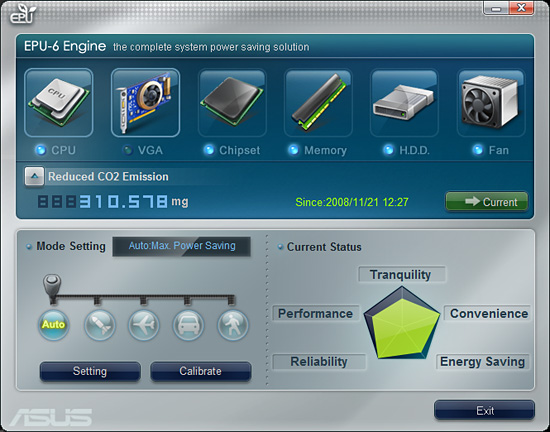Intel X58 Motherboard Roundup - What does $300 Get You?
by Gary Key on December 5, 2008 3:00 PM EST- Posted in
- Motherboards
ASUS P6T Deluxe
Features

ASUS offers the P6T Deluxe in two different versions, one with the OC Palm external display module for $338 and one without for $299. The OC Palm was originally introduced as the ScreenDuo last year and features a 2.5" QVGA display, four-way directional pad, and four input buttons. It attaches to the motherboard via a USB cable and features a clean, uncluttered, and simplistic interface that allows the user to interface with various ASUS software programs. The user can monitor various hardware functions or do on-the-fly overclocking. The unit allows real-time changes to the processor's Bclk along with voltages for QPI, memory bus, and the CPU. We would like to see additional overclocking variables along with the ability to save profiles to the BIOS or real-time changes to the BIOS. Overall, it is a unique feature and fun to play with for about 30 minutes, but for most users we would suggest saving the money and buying the base board - A board that we might add is one of our favorites in the lab since it first arrived.
Not to take anything away from our other boards as they are all very good with one bordering on being great, but the ASUS P6T-Deluxe impressed us with its ability to just work as expected out of the box. While we provided several suggestions to ASUS for improvements, they mainly centered on tuning aspects, not getting basic functions to work properly before we could even consider testing. That may seem trivial, but unfortunately it is not if you are an early adopter of high-end motherboards.
The BIOS is designed for a wide variety of users who want to get the most out of a board when overclocking. Some of the voltage ranges are not as wide as Gigabyte's, nor do you have the ability to control each individual memory channel, but the options available will more than suffice for most users. We also think the ASUS BIOS is more user friendly due to the information provided for each option. However, ASUS continues to use the terminology QPI/DRAM instead of VTT as the other boards do.
ASUS features memory speeds from 800MHz to 2133MHz memory for the i920/i940 processors along with opening up QPI link speeds from a standard 4.800 GT/s up to 6.400 GT/s. We are disappointed with the number of OC profiles in the BIOS. ASUS has three OC profiles compared to up to eight on the other boards.
The board officially supports 12GB of DDR3 memory, although we expect full support for 24GB in a future BIOS release. Running 12GB of memory on this board is extremely easy and it usually requires less voltage while providing tighter timings than the other boards. Our 12GB Patriot and G.Skill DDR3-1600 kits were 24/7 stable at 1600 with 8-8-8-24 1T timings, although we needed about 1.66V for absolute stability. The Gigabyte board offered slightly better latency results with 9-8-8-24 1T timings, but the ASUS board was just slightly faster in most of the benchmarks except for WinRAR. Of course, your mileage will vary with different memory kits and sub-timings, and outside of memory benchmarks the net difference is generally less than 1%.
One last item of note, at least in this first look, is that the three PCI Express 2.0 x16 slots will operate in x16/x16 mode for 2x SLI/CF if the third x16 slot is empty. If you decide to place a PCIe RAID, network, audio, or TV tuner card in the third x16 slot, then the 2x SLI/CF configuration will operate in x16/x8 mode. We did not notice any performance differences between the two modes with our HD 4870 or GTX 260 cards. 3x SLI/CF configurations will run in x16/x8/x8 mode. You can also use the first and third x16 slots for graphics if you need to open up a PCI slot but the board will run in x16/x8 mode. Although the owner’s manual states the three x16 slots are for graphics cards only, we had no problems running our ASUS Xonar D2X or Highpoint Rocket RAID cards in x16 slot two or three.
The Board


The P6T Deluxe carries over the orange and black decor from previous ASUS DDR3 boards along with a blue and white slot motif. While not exactly as colorful as previous Gigabyte boards or as subdued as the MSI board, it does work well enough; we prefer the flagship ROG color palettes. ASUS has constantly improved their layouts over time and the P6T Deluxe reflects this with a design that is virtually free of clearance problems. While not as loaded as the Gigabyte board, ASUS still has a substantial amount of items to squeeze onto the motherboard.
The first item we notice on the P6T Deluxe is the heatsink and thermal pipe setup encircling the CPU socket area. The CPU socket is centered to the DIMM slots as we noticed on the Gigabyte board. The engineers tell us this is to optimize the memory trace paths resulting in higher overclocks and improved stability. The various heatsinks are low-profile designs featuring a completely passive setup in order to keep noise to a minimum. ASUS utilizes a swept fan design for the northbridge, a small but effective fin array for the ICH10R, and a couple of relatively low-profile fin arrays for the PWM area.
All of this equates to a CPU area that is basically void of clearance issues with large air coolers, although the capacitors are little close to the 1366 socket for the more extreme cooling options. The P6T Deluxe features 23 power phases, which certainly sounds impressive, but we are still not sure if quantity is better than quality in this regard. ASUS dedicates 16 for the processor core and another three memory, two each for the memory/QPI controller and chipset. The Gigabyte and MSI boards feature two individual two-phase designs for the memory and QPI systems.
On the other end of the board we have a bevy of SATA ports and the IDE connector. The six red ports are tied to the ICH10R while the two orange ones attach to a Marvell 88SE6320 Serial Attached SCSI controller. Backwards compatibility built into the SAS standard allows current SATA drives to work. When utilizing a standard SATA drive, performance is close to the ICH10R and definitely a step ahead of the JMicron controllers on the other boards. As a plus, it will do RAID 0 and 1 arrays, and ASUS includes SAS cables in the box. We appreciate the right angle connectors as they ensure there will not be any clearance issues with longer cards. However, ports 5 and 6 use a standard design that results in a very tight fit with a couple of GTX280s installed.
ASUS includes onboard power and reset buttons, but curiously forgot to include a clear CMOS button. After weeks of testing, it is a feature we miss, even though ASUS' BIOS recovery system rarely let us down. Moving forward, we have three physical x16 slots available for graphics in a x16/x8/x8 configuration with a 3X setup. In order to run a 3X setup, the second GPU will have to be a single slot solution... which sort of defeats the purpose of 3-way support, since the current NVIDIA 3-way SLI cards are all dual slot solutions. Still, you can add in a card for PhysX processing if you'd like. In a 2x CF/SLI setup, the user ends up with a x16/x16/x1 configuration. An additional x4 slot is at the top of the board that can accommodate full length cards. To top it off, two PCI slots are available, but the first one will be blocked by double-slot graphics card.
ExpressGate is included on this board and the riser card is located between the second PCIe x16 and PCI slots. In addition to the riser card, the board features onboard headers for an additional IEEE 1394a port and six USB ports. The user ends up with a total of 14 usable USB ports, two more than the ICH10R supports. That means some sharing is going on between the ports, but we never noticed a problem with the board loaded out.
Finally we get to the IO panel that features a single combo PS/2 port, eight USB ports, two Gigabit LAN ports, a single IEEE 1394a and eSATA port, and optical and coaxial S/PDIF out ports. The audio panel features connection jacks to the Analog Devices AD2000B codec, probably the last time we will see this codec since ADI has exited the PC audio business.
The Application

TurboV is ASUS' latest Windows based overclocking utility that features the ability to change most major BIOS settings to improve overclocking rates. It features profiles and works quite well, provided the memory timings and CPU multiplier have been set up properly prior to entering Windows. We are still hopeful that one of the major suppliers will offer the same capabilities as AMD's AOD utility.

The P6T Deluxe features the EPU-6 power savings technology that can be accessed through the EPU software. The program offers five different modes or levels of energy savings. After hours of testing each setting, we found that leaving the application on Auto with a proper calibration worked best. Utilizing EPU-6 resulted in a power savings of 5W at both idle and load settings.
















78 Comments
View All Comments
Elvis2 - Sunday, December 7, 2008 - link
i'm tired of being a free beta tester for these "top" tier manufacturers (remembering my E7205 days). If I'm going to spend $300.+ on a motherboard, I expect it to work AS ADVERTISED. I used to upgrade every year but for the past couple, I've been hesitant to do so. I don't want to fork over my hard earned cash (particularly in this economy)for a new rig only to spend hours on the phone with some tech support guy that dosen't know half of what I do ( let's start on page ten ok?)and wait weeks for a bios that corrects the problem. My Opty rig has been incredibly stable while producing a 50% o/c (thanks eVGA)but is getting long in the tooth. I run SLI and have been waiting on an Intel chipset that supports it. I'm going back to intel and the i7 920...maybe. I'm going to wait a couple of months tho. Bleeding edge, spending that kind of coin, and the hassle of working out the bugs, after fifteen years it's not worth it to me.Sorry for the rant. Jmh $.02.
btw, great article.
fausto412 - Sunday, December 7, 2008 - link
There isn't one board manufacturer thatdoesn't have a bunch of people complaining in the forums all over the internet. Anand's opening explains why.I hate upgrading bios expecting better stability or performance and getting more problems or no fixes.
Gary, i think it is time to have some kinda of database that covers all boards and their known issues going back 2 years or to the 3 series boards. if the flag ship board has a problem then by extension lower end boards have that problem. if they didn't care to make their product the best then that is their problem. GIVE THEM BAD REVIEWS so that they get on the ball.
I never knew Anandtech went back and forward with the board makers as if you're beta testers.
We need to do something to make things better
strikeback03 - Monday, December 8, 2008 - link
I'd argue that it is entirely possible for the flagship product to have problems that lower-end products do not. Expensive X58 is the only option for now for i7 processors, but look back at LGA775. I wouldn't be at all surprised if some stability compromises were made on X38/X48 boards in pursuit of higher SuperPI numbers, while those same compromises are probably not present in the mainstream P35/P45 boards of the same age. Motherboards are one area where I can see going with a mid-level (~$90-130 for LGA775) product might give a better result for the majority of users than jumping to the high end would.borneoo - Sunday, December 7, 2008 - link
Beside the GHz, and MB/s would be good to have a chart/list, which shows the problems of the parts, and aggregated charts to show problems belongs to the same company, ... or SEARCHABLE DATABASE about errors related to products / companies and solutionsJonnyDough - Sunday, December 7, 2008 - link
"Our plan is to cycle through each manufacturer so we are not singling out any one supplier but we are going to be brutally honest in our assessments in these particular focus reviews." (the quote button never works for me in Firefox. Plz fix)Awesome. At least someone is. I think a "two strikes before we post" policy is fair.
DandAG - Sunday, December 7, 2008 - link
After reading the first page of this article “Intel X58 Motherboard Roundup - What does $300 Get You?”, I started reading all the blogs. At first I agreed 100% with Anand’s comments, and wanted to jump on the band wagon like everyone else, but then I read some of the response. Realistically, review sites can’t use the boards under test with ALL the different software/hardware configurations consumers will, and they cannot postpone a review until all the BIOS and operating bugs are fixed…they would be releasing a review a year (or more) after the next generation hardware has already hit the market. People don’t visit these review sites to see how good a DDR2 system is compared to a DDR system, they come to these sites to read about the future, to get the “inside scoop” as to what the manufacturers are thinking up next, and to see the new features of hardware out there today because they are thinking of upgrading right now. To read about overclocking and performance comparisons is really just a bonus for the overwhelming majority. Most people just jump to the conclusion page to see if the reviewer recommends the product or not. We’ve all done it.Review sites need the merchandise to review and the funds to stay afloat, so upsetting certain manufacturers is not in their best interest. They can get away with critiques, questions, “less than expected” reviews, and some (very little) criticisms, but if they were to only give bad reviews every time, manufacturers would stop sending them products to review. And if you think that is a good thing, “they’ll just purchase the final release like the rest of us and provide a balanced review”, think again. If a review site did that, 1) it would have to advertise like crazy to maintain its purchasing ability, 2) not be able to provide future analysis, 3) and not provide the consumer anything more than what “free” chat rooms/manufacturer message boards give you.
I agree there needs to be an industry-wide change; a change in R&D, change in QC, and a change in review process and reporting, BUT the real change has to come from the consumer. We the purchasers of their merchandise have to take a stand, bite the antiquated hardware bullet, and wait to buy until all the bugs are fixed (at least to a reasonable state). As long as we continue to want to be “the first” or “the fastest”, manufacturers will continue to scramble to be first on the market with crap that can or cannot be fixed later on.
Don’t jump down the throats of review sites like AnandTech; instead tell them what YOU want to read about. Give these sites constructive criticism, and suggestions to better themselves like Christoph, Gary, Anand, and all the other reviewers here give the manufacturers. The old “if you don’t have anything better to say, then don’t say anything at all” thing.
Personally, I would love to have AnandTech continue to review the next best thing before it hits the market just to see what the manufacturers are planning and whether or not the reviewer thinks upgrading will be worth it, BUT I also want them to then purchase that same item over-the-counter for a “final look” review, and then tell it like it is. Of course that can’t be done with all items initially reviewed (too time consuming), but the items that bloggers have shown the most interest in.
Steve Z - Sunday, December 7, 2008 - link
First, kudos for reqiring reliability. I've now bought the ASUS board. I won't overclock because I know what gate stress does to CMOS electronics (I slowly destroyed a chip I was testing at an elevated voltage. 18 hours is not enough time to run a $300 CPU). I use my computer to get work done and view overclockability as an indication of robustness in the board's engineering. If it's not - I need to know this. Thank you Gary and Anand - beleive me, $100 extra is a small price to pay for a motherboard that will not waste days of my time trying to get it to work.Second, a notice to those of you who are going to buy the ASUS board. They put the "Crash Free BIOS utility" and the driver installation utility on the same CD. Since installing all the drivers takes 3 restarts, imagine my surprise when installing the ethernet drivers did several surprise BIOS flashes (I didn't even know what was happening at first and I reset the system a few times during the process. To ASUS's credit, the board recovered).
If I pay $300+ dollars for a board, I expect them to pay the extra 5 cents and include a second CD. When you go through your three restarts, make sure you remove the disk every time then put it back in once the OS starts up. Shame on you ASUS for the oversight.
That said, everything is working well now. I hope I didn't buy a product from the company who thought it was only OK for 3 GB to run reliably as I'm running 6 GB now and will go up at some time in the future since I run math sims.
cheers,
--Steve Z.
RagingDragon - Sunday, December 7, 2008 - link
Reading the sections on each board, I think the ASUS was the only board which fully worked, out of the box, with 12GB of RAM. This strongly implies they were *not* the 3GB company.It's hinted the Gigabyte had some undescribed issues with 12GB and older BIOS's, and it's stated that the EVGA also had undescribed issues with 12GB (no indication whether those issues were at stock speeds or when overclocking). The MSI still has issues overclocking 12GB or RAM - nothing said about whether it worked at stock speed out of the box.
LeeKay - Saturday, December 6, 2008 - link
I bought the GA-EX58-Extreme as I posted in the forums the quality of the board is the best I have seen but support wise and bios wise this board sucks worse than any board I have had. For a motherboard to have issues when I use 12GB is beyond me. I want to use this pc for everything from online banking thru gaming for the wife my son and me and to do video editing. Right now I can just run Need for speed undercover at any resonable clock speed without it crashing. Thats as of F4j. And I still can not let my board go to sleep with S3 enabled nor can I expect my Data drives running on the hardware raid controller to recover in S3 mode nore can I run my pc with any of the energy saving options in the bios. Oh and I cannot run my memory at 12gb and at 1600Mhz just noway in hell it will be stable. I have to run it at 1333mhz. I cant run SLI and have my X-FI PCI sound card in either PCI slot and have the pc boot into windows. It just blue screens with the latest Bios. (I am running 2 280GTX with single slot active cooling).The good note is to run at 4.13ghz I am running 1.425v without loadline correction. its stable and with the above taken into account far better tha the past issues.
Sunsmasher - Saturday, December 6, 2008 - link
Your comments are extremely well thought out and relevant.The idea that $300(!) motherboards don't work reliably upon release
is beyond ridiculous.
I think your plan to write an as-is review initially in a great idea.
This will give early buyers a true heads-up on what they're getting.
And then later, you can perform your invaluable beta feedback service to the manufacturers and your readers.
Hopefully, this policy will cause improvements on the QC end.
Thanks again for being so on top of it!